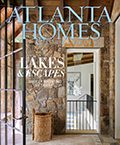Country Revival
Atlanta architect Keith Summerour challenges himself and his budget by designing a rural retreat that incorporates tried-and-true details from a bygone era.
Keith Summerour had something to prove. Having just completed the soaring Towerhouse on his rural Meriwether County cattle farm before the economy tumbled, the notable Atlanta architect wanted to show his clients just how versatile he could be.
In that spirit, Summerour—along with his wife, Karen, and colleague Ed Belding— designed and built this 30×42-foot guest house to be a model of efficiency, making a modest budget and careful space planning top priorities.
“The budget was very important because it came at a time in which the economy had crashed, particularly for architects. I wanted to prove to my clients that architects can build something affordable that is still charming,” says Summerour.
Turning to the classic dog trot house for inspiration—a style known for its center breezeway—Summerour experimented with just how small and inexpensive a home he could create while still maintaining an open, comfortable feeling for guests.
By closing off the traditional breezeway at each end with doors, Summerour maintained the integrity of the original Cracker style while converting the breezeway into a living room space with three bedrooms and the kitchen opening directly off it.
“Everybody who has stayed there is surprised by how big it seems,” says the architect of his guests’ reaction to the space. “Basically, it is a five-room house, but it sleeps a lot of people. It has five queen-size beds and 10-foot ceilings.”
Also true to the Cracker style, Summerour brought in boulders instead of concrete to anchor the home, raising the foundation to increase air flow beneath it. Additionally, directly aligned front and back doors allow easy air flow, upping the energy-saving effort and decreasing utility bills.
“In the summertime, rarely do you need air conditioning because the air goes underneath the crawl space and flows through the middle of the house,” he says. “This is a timeless feature that still works.”
On the front porch, Summerour continued the rustic charm by repurposing rough-hewn cedar trees, hand cut right on the farm for the railings. And on the screen door, the rooster kick panel was hand drawn and punched with a nail, adding country charm to the entry.
Throughout the interior, the architect opted for wood paneling rather than drywall, swathing the mix of reclaimed and off-the-shelf boards himself in a light lime wash—the same that would have been used before the advent of latex- or oil-based paints.
Smaller touches in the kitchen, like a utility sink and old thread spools used as cupboard knobs, infuse Southern charm into the already rustic space. And instead of conventional cabinets, Summerour used large furniture pieces and a stand-alone range, echoing the style and look of the original Cracker houses. For the windows and doors, he even used mismatched, reclaimed pieces, creating a cottage look that appears to have evolved over time.
The two bedrooms, which feature floor-to-ceiling headboards, are reminiscent of boats. Summerour commissioned a craftsman to build them using old barn wood.
Out front, lights strung from the guest house to the nearby barn illuminate a courtyard that serves as the gateway to the Towerhouse. “What is neat about the courtyard is it is almost like a miniature piazza,” Summerour says, adding that it’s perfect for parties under the stars.
In the end, Summerour was able to finish the project well under budget. Coming in at just $65 per square foot, he proved that good design is not about price, after all.
Read about Towerhouse, the primary residence at Summerour’s farm, in the August 2009 issue of Atlanta Homes & Lifestyles or at atlantahomesmag.com/article/view-here.
Architect Keith Summerour, of Summerour Architects, breaks down the cost of constructing his guest house at Towerhouse Farm
• Boulders from the property were used for the foundation, so the only cost was labor; there was no need to bring in a concrete truck.
• The windows and doors were reclaimed at no cost. This created a cottage appeal in that the different windows make the building look old, as if it has been added onto over time.
• Wooden thread spools—all purchased for $1—were used for door hardware.
• There is no cabinetry in the house, only freestanding furniture, tables and bookshelves.
• There is no tile in the house; fiberglass tub and shower units from Kohler are disguised with shower curtains.
• In total, we spent about $65 a square foot for a 30×42-foot building—about $85,000 total.
Architecture Keith Summerour, Summerour Architects, (404) 603-8585; summerour.net



















